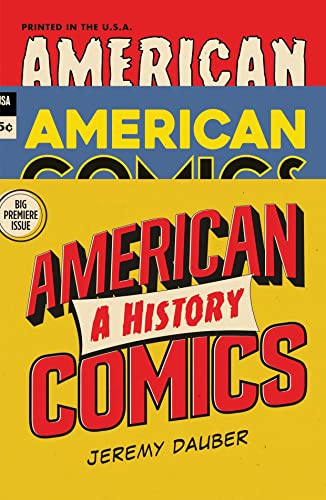American Comics: A History

“No detail escapes Dauber. . . . A master storyteller . . .”
Jeremy Dauber covers the impressive sweep of comics as a literary and artistic genre from the early days of the “Sunday funnies” to today’s award-winning graphic novels. No detail escapes Dauber. He covers the changing visual layouts, starting with the single scene captioned comics of the late 1800s to the sophisticated pages of today’s graphic novels. He describes printing processes and the development of separate magazines and books that told stories with panels and speech bubbles. He even knows the details of how creators were paid (or not) for their contributions. And, of course, he describes the stories themselves, from the silly to the adventurous to the satirical to the deadly serious. There isn’t a subject that is off-limits to this richly creative format.
As one would expect from any responsible historian, Dauber doesn’t ignore marginalized writers, illustrators, and characters, tracking racism and sexism in each. As a professor of Jewish literature, he’s particularly good at conveying the Jewish contribution to the medium, which was not insignificant. It’s widely known that the creators of Superman were Jewish, but readers are probably less aware that the first color funny pages appeared in The New York Herald thanks to Joseph Pulitzer, the namesake of his famous prize. Indeed, comics began as quintessentially immigrant reading, the pictures helping to make the meaning of the words clearer.
Dauber presents the medium’s political history both in terms of shifting subject matter and the response of more traditional organizations. In particular he lays out the 1950s “Code” that censored comics much as it censored movies, making sure stories were wholesome and appropriate for young readers:
“The Code took Wertham’s argument about comics’ formative influence for granted, at least rhetorically, forbidding crimes to be presented ‘as to create sympathy for the criminal, to promote distrust of the forces of law and justice, or to inspire others with a desire to imitate criminals,’ instead to be depicted as ‘a sordid and unpleasant activity.’ . . . The Code toned everything down, prohibiting ‘scenes of excessive violence,’ asking for ‘restraint,’ in using the word crime in comics titles, and outright prohibiting the words horror or terror there. . . . ‘Slang and colloquialisms are acceptable,’ the Code allowed, but ‘excessive use should be discouraged and wherever possible good grammar should be employed.’ Elementary school teachers nationwide might have cheered, but did anyone else?”
Comics, however, weren’t just funny business. They spoke “mature truth to political power,” and introduced readers to difficult subjects they wouldn’t hear about otherwise. Art Spiegelman’s Pulitzer Prize-winning Maus was one such work. Mad magazine’s sharp satires were another. Maus, in fact, was the beginning of comics being taken seriously as literature. The New York Times called it “one of the most powerful and original memoirs to come along in recent years.” And with that, graphic novels were no longer pigeon-holed as childish or lesser. That trend has continued, flourishing even more in recent decades when so many graphic novels have become prize-winning mainstream bestsellers, including the graphic adaptation of the 9/11 Commission Report.
Librarians and teachers have gone from considering comics as a kind of literary junk food to clamoring for more of them. Dauber manages to follow all of these disparate elements, describing numerous comic classics along the way (from Peanuts to Asterix to the Watchman series and everything in between). The steep rise in Comicon conventions even merit a chapter. The one fault to this encompassing study is that it doesn’t have a single picture (probably due to licensing complications). That’s unfortunate in a book that describes so well the power of imagery to convey meaning. Readers will be forced to track down the cited works, but they won’t be disappointed once they do.
Dauber ends his book with rich praise for this versatile medium, this visual storytelling that resonates so deeply in us it has survived a harsh Code, political strife, economic struggles, and competing media. A master storyteller, Dauber shows us just how much there is to appreciate in this uniquely American history.